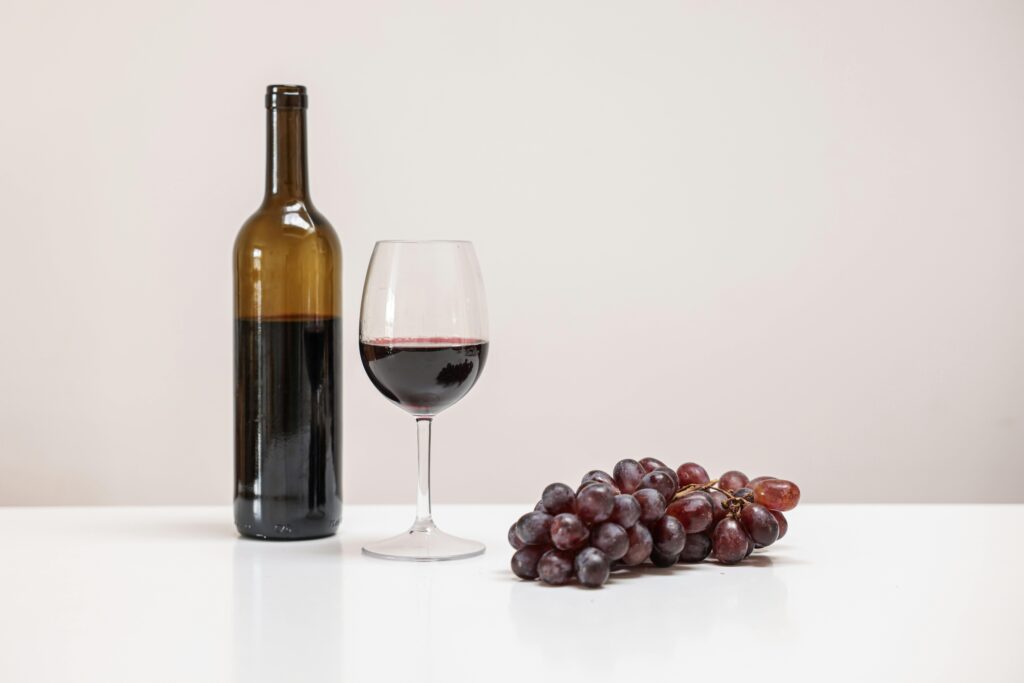When it comes to elevating your cooking, few ingredients offer the depth and richness of dry red wine. Whether you’re braising meats, crafting a classic Bolognese, or deglazing a pan for a savory sauce, the right red wine can add complexity, acidity, and aroma that water or broth simply can’t match. But not all wines are created equal in the kitchen. Choosing a dry red wine with the right balance of tannins, acidity, and body is essential for enhancing not overwhelming your dish.
In this guide, we’ll walk you through the best dry red wines for cooking, explain what makes them ideal for culinary use, and share tips on how to use them effectively. Whether you’re a home cook or a seasoned chef, the right wine can take your recipes to the next level.
Hey, before we uncork the best dry red wines for cooking, let’s set the table for stress-free meal prep. Great dishes start with great planning, and home cooking is the secret to unforgettable flavors. ReciMe’s got your back – this recipe organizer app lets you import recipes from Instagram or Pinterest, map out your weekly meals, and whip up grocery lists sorted by aisle in seconds. Download ReciMe now, streamline your kitchen vibe, and let’s dive into those wine picks!


1. Cabernet Sauvignon
Cabernet Sauvignon is one of the most popular dry red wines used in cooking. Known for its bold flavor, high tannins, and full body, it brings a rich intensity to slow-cooked dishes like beef stews, braised short ribs, and hearty red sauces. Its deep flavors of blackcurrant, plum, and subtle spice can enhance the taste of meats and sauces without getting lost during long simmering.
Because of its strong structure and complexity, Cabernet Sauvignon holds up well to high heat and long cooking times. When reduced, it creates a luxurious base for sauces and gravies that cling beautifully to roasted meats or pasta. If you’re looking to build deep, meaty flavors in your dish, this is a go-to varietal.
Key Highlights:
- Bold, full-bodied flavor with firm tannins
- Excellent for braised meats and reductions
- Enhances depth in sauces and stews
Who it’s best for:
- Home cooks making rich meat dishes
- Chefs looking for structure in reductions
- Fans of robust, intense flavor profiles
2. Merlot
Merlot is a soft, medium-bodied red wine with lower tannins and fruit-forward notes that make it highly versatile in the kitchen. With flavors of black cherry, plum, and a hint of chocolate, it brings a smooth, rounded depth to dishes like tomato-based sauces, sautéed mushrooms, and even certain poultry recipes.
Unlike more aggressive reds, Merlot won’t overpower delicate ingredients, making it a safe and flexible choice. It’s ideal for recipes that call for wine but don’t require long reductions or heavy meat. Its friendly flavor and moderate acidity allow it to balance richness without dominating the dish.
Key Highlights:
- Smooth, fruit-forward flavor
- Pairs well with lighter red sauces
- Easy to find and budget-friendly
Who it’s best for:
- Beginner cooks exploring wine-based recipes
- Pasta lovers using red sauces
- Those seeking a gentler, balanced red
3. Pinot Noir
Pinot Noir is a lighter dry red wine that’s perfect for recipes requiring subtlety and finesse. With its delicate flavors of cherry, cranberry, and earth, it pairs well with pork, poultry, mushrooms, and dishes that need a touch of acidity without overwhelming depth. Pinot Noir is particularly great for coq au vin or red wine reductions where a lighter wine enhances the sauce.
Because of its lower tannins and higher acidity, it’s one of the few red wines that can work well with more delicate proteins and even some vegetable-based dishes. Its nuanced flavor makes it a favorite for chefs who want a red wine that plays a supporting role rather than stealing the spotlight.
Key Highlights:
- Light-bodied with high acidity
- Great for poultry, pork, and mushroom dishes
- Adds elegance without heaviness
Who it’s best for:
- Cooks preparing delicate meat or mushroom dishes
- Fans of French-inspired cooking
- Those seeking subtle, refined flavors
4. Zinfandel
Zinfandel, when dry, is a bold red wine known for its fruity and spicy profile, making it a great match for rich sauces, barbecue-style dishes, and braised meats. It features notes of blackberry, pepper, and sometimes even smoky undertones, which can add complexity to chili, ragu, and other slow-cooked recipes.
Its slightly higher alcohol content helps it stand up to heat during reductions, while its jammy character complements dishes that benefit from a little natural sweetness. Zinfandel is especially good in tomato-based or spicy dishes where you want to highlight sweetness and warmth without added sugar.
Key Highlights:
- Fruity and spicy profile
- Ideal for barbecue sauces and spicy stews
- Enhances dishes with smoky or sweet notes
Who it’s best for:
- Fans of bold and spicy food
- Home chefs making chili or ragu
- Cooks seeking a sweeter red wine alternative
5. Syrah / Shiraz
Syrah, also known as Shiraz in Australia, is a powerhouse dry red wine full of dark fruit, pepper, and smoky flavors. Its bold character makes it perfect for red meat recipes like lamb, grilled steak, or game. The wine’s natural intensity brings a strong, rich base to sauces and reductions, especially when paired with garlic, rosemary, or bold spices.
With high tannins and a rich mouthfeel, Syrah holds up well in recipes with long cooking times. It’s especially useful for Mediterranean and Middle Eastern dishes where the flavors are already bold and aromatic. This wine adds both color and depth to any dish it touches.
Key Highlights:
- Dark fruit, pepper, and smoky undertones
- Great for lamb, beef, and grilled meats
- Builds strong, full-bodied sauces
Who it’s best for:
- Grill masters and meat lovers
- Cooks using bold spices and herbs
- Fans of rich, concentrated flavor
6. Chianti
Chianti is a dry red wine from Tuscany, Italy, made primarily from Sangiovese grapes. Known for its high acidity, moderate tannins, and flavors of cherry, herbs, and earthy spice, it’s an ideal companion for tomato-based dishes. Chianti complements Italian recipes like Bolognese, lasagna, or chicken cacciatore with balance and brightness.
Because of its acidity, Chianti enhances and elevates the natural umami of tomatoes without overwhelming them. It reduces into a flavorful base that deepens the taste of sauces, making it one of the best options for rustic, savory cooking. Its food-friendly nature has made it a staple in kitchens around the world.
Key Highlights:
- Bright acidity with cherry and herbal notes
- Pairs perfectly with tomato-based Italian dishes
- A classic choice for rustic home cooking
Who it’s best for:
- Italian cuisine enthusiasts
- Cooks using lots of tomato sauce
- Fans of rustic, earthy flavors

7. Tempranillo
Tempranillo is Spain’s signature grape and is often used in Riojas and Ribera del Duero wines. It has medium tannins, a balanced profile, and flavors of red fruit, tobacco, and leather. This makes it a fantastic wine for cooking dishes like beef empanadas, lamb stew, or smoky bean soups.
Tempranillo’s balance of fruit and earthy notes gives it great versatility in the kitchen. It’s especially good for dishes that need complexity without becoming too rich. Whether you’re making tapas or a full Spanish-style braise, Tempranillo adds depth and a touch of old-world character.
Key Highlights:
- Balanced fruit and earthy flavors
- Ideal for Spanish-style stews and braises
- Medium tannins, very versatile
Who it’s best for:
- Cooks of Spanish or Mediterranean dishes
- Those seeking a wine with subtle depth
- Fans of old-world, savory wine
8. Malbec
Malbec is a dark, full-bodied red wine primarily from Argentina and France. Known for its bold tannins, blackberry and cocoa notes, and smoky finish, it adds depth to hearty dishes. It’s excellent in red wine reductions for grilled meats, beef pot roast, or mushroom sauces.
Because of its strong structure and intense character, Malbec doesn’t get lost in the pan. It holds up well to robust ingredients like garlic, herbs, and gamey meats. Its deep color also gives sauces and stews a rich, luxurious look and flavor.
Key Highlights:
- Dark fruit, cocoa, and spice profile
- Best for hearty, meaty meals
- Produces thick, flavorful reductions
Who it’s best for:
- Lovers of bold, intense flavors
- Cooks working with beef or lamb
- Fans of rich, velvety sauces
9. Barbera
Barbera is another Italian varietal, often overlooked but perfect for cooking. It’s known for its high acidity, low tannins, and notes of cherry, raspberry, and dried herbs. Its light body and vibrant profile make it perfect for pan sauces, roasted vegetables, or lighter meat dishes like pork tenderloin.
Unlike some reds, Barbera doesn’t overwhelm subtle dishes. Its acidity helps to brighten and balance flavors, making it a great cooking wine when you want complexity without weight. It also performs well in fast-cooked sauces where bolder wines might feel too heavy.
Key Highlights:
- High acid, low tannin red
- Great with vegetables and lean meats
- Brings balance and brightness to sauces
Who it’s best for:
- Fans of lighter red wines
- Cooks making veggie or pork-based meals
- Anyone seeking acidity without heaviness
10. Grenache (Garnacha)
Grenache, also known as Garnacha in Spain, is a fruity and spicy red wine with moderate tannins and alcohol. With flavors of strawberry, white pepper, and dried herbs, it’s an ideal red for dishes needing a touch of warmth and sweetness, such as ratatouille, lamb tagine, or spiced lentils.
This wine offers flexibility in cooking – it works well in both meat and vegetarian recipes. Its mellow tannins make it less likely to become bitter when reduced, and its natural sweetness complements savory spice beautifully.
Key Highlights:
- Fruity with warm spice notes
- Works well in both meat and vegetarian dishes
- Doesn’t turn bitter during reduction
Who it’s best for:
- Home cooks who enjoy North African or Mediterranean flavors
- Fans of sweet-savory balance
- Those avoiding bitter tannins in reduction
11. Pinotage
Pinotage is a uniquely South African red wine, a hybrid of Pinot Noir and Cinsault, with bold flavors of dark berries, smoke, and earthy undertones, ideal for slow-cooked meats and grilled vegetables. It has bold flavors of dark berries, smoke, and earthy undertones, often with a touch of coffee or chocolate. This complexity makes it an excellent companion for slow-cooked meats, grilled vegetables, and stews with bold seasoning.
In the kitchen, Pinotage performs well in both reductions and marinades. Its smoky edge adds character to dishes that are roasted or barbecued. Because of its intensity and body, it can stand up to spices without clashing, making it a reliable choice for exotic or fusion recipes.
Key Highlights:
- Distinct smoky, earthy, and dark fruit flavors
- Great for grilling, roasting, or stews
- Holds up well to spice and bold flavors
Who it’s best for:
- Adventurous cooks exploring new cuisines
- Fans of robust, complex wines
- Anyone making smoky or barbecued meals
12. Nero d’Avola
Nero d’Avola is Sicily’s most famous red grape, known for its rich blackberry notes, medium tannins, and soft spice. It’s a full-bodied wine that brings depth and richness to any dish, especially those with tomato sauces, braised meats, or Mediterranean herbs.
This wine’s structure makes it a great substitute for Cabernet in recipes where you want boldness but less tannin. It reduces beautifully, enhancing sauces with a velvety texture and subtly fruity finish. Nero d’Avola is perfect for pastas, eggplant parmesan, or slow-cooked lamb.
Key Highlights:
- Full-bodied with blackberry and spice
- Excellent for braises and Italian-style dishes
- Adds richness without excessive tannins
Who it’s best for:
- Mediterranean cuisine lovers
- Cooks needing a Cabernet alternative
- Home chefs working with lamb or eggplant

13. Mencia
Mencia is a lesser-known Spanish varietal that offers vibrant acidity and flavors of red berries, pepper, and floral notes. It’s lighter than Rioja but still structured enough for cooking. Its fresh profile makes it ideal for lighter sauces, pork dishes, and anything with herbs or mushrooms.
In the kitchen, Mencia shines in quick reductions and pan sauces. It adds brightness without overpowering the dish and keeps flavors crisp. If you’re cooking something that needs elegance rather than weight, Mencia is a brilliant choice.
Key Highlights:
- Lively acidity and red berry flavors
- Great with herbs, mushrooms, and pork
- Adds freshness to sauces and glazes
Who it’s best for:
- Cooks who prefer elegant, light reds
- Fans of mushroom- or herb-heavy recipes
- Those wanting a fresh wine reduction
14. Sagrantino
Sagrantino is a bold, tannic Italian red from Umbria, rich with plum, black cherry, and licorice notes. It’s one of the most tannic wines in the world, which means it must be used in the right context such as rich stews, oxtail, or dishes with lots of fat.
Its natural power allows it to break down and enrich dishes that need long simmering. If you’re braising fatty cuts or preparing something like osso buco, Sagrantino adds incredible structure and depth, transforming the sauce into something decadent.
Key Highlights:
- Exceptionally bold and tannic
- Deep fruit with licorice and spice
- Perfect for long-simmering meat dishes
Who it’s best for:
- Chefs cooking fatty, rich cuts of meat
- Fans of Italian braised recipes
- Those who love structured, complex reductions
15. Zweigelt
Zweigelt is Austria’s most widely planted red grape. It delivers bright cherry flavors, soft tannins, and a hint of black pepper. Light to medium in body, it works beautifully in quick pan sauces or lighter meat preparations like veal, chicken thighs, or pork medallions.
Its acidity helps lift dishes without being overwhelming, and its fruit-forward nature keeps flavors accessible. Zweigelt is also ideal for wine reductions that need a more delicate touch, especially when served with cream-based elements or buttery sides.
Key Highlights:
- Cherry and spice flavors with soft tannins
- Great for quick sauces and light meats
- Works well in cream or butter-based dishes
Who it’s best for:
- Home cooks preparing lighter proteins
- Fans of gentle, fruity reds
- Those making quick, pan-based reductions
16. Gamba di Pernice
Gamba di Pernice is a rare Italian varietal from Piedmont, offering concentrated flavors with a spicy, herbal character, suitable for both light and hearty dishes. Despite its light color, it offers concentrated flavors with a spicy, herbal character and notable aging potential. This wine’s unique profile makes it a versatile choice in the kitchen, adding depth to a variety of dishes.
In cooking, Gamba di Pernice enhances both lighter white meat preparations and slow-cooked, concentrated beef stews. Its balanced acidity and refined flavors contribute complexity without overpowering the dish, making it suitable for a range of culinary applications.
Key Highlights:
- Spicy and herbal notes with concentrated flavors
- Light color with medium body
- Versatile in pairing with various dishes
Who it’s best for:
- Chefs seeking a unique Italian varietal
- Cooks preparing both light and hearty meals
- Enthusiasts of rare and distinctive wines
17. Mukuzani
Mukuzani is a dry red Georgian wine made from Saperavi grapes in the Kakheti region. Aged in oak casks for at least three years, it boasts a deep red color with a soft smoky scent of oak and berry. The wine’s complex profile, featuring dry beginnings that evolve into rich oak and fruit flavors, makes it a distinguished choice for culinary use.
In the kitchen, Mukuzani pairs exceptionally well with steaks and dark meats. Its matured character and balanced acidity enhance the flavors of hearty dishes, adding a sophisticated touch to traditional recipes.
Key Highlights:
- Deep red hue with oak and berry aromas
- Complex flavor profile with aging
- Ideal for pairing with robust meats
Who it’s best for:
- Cooks aiming to elevate meat dishes
- Fans of aged, complex wines
- Those exploring Georgian wine varieties
18. Cahors (Malbec)
Cahors is a French dry red wine made predominantly from Malbec grapes, originating from the southwest of France. Known for its deep, dark color and earthy, tannic structure, Cahors brings intensity and rustic charm to the culinary table. With flavors of dark berries, tobacco, and hints of spice, this wine adds a robust, savory element to meals.
In cooking, Cahors pairs wonderfully with braised meats, mushroom sauces, and game dishes. Its pronounced tannins and depth of flavor stand up well to slow-cooked and richly seasoned ingredients, enriching the final dish with complexity and a touch of French heritage.
Key Highlights:
- Earthy and tannic with dark berry notes
- French Malbec with strong regional character
- Great for deep, savory dishes
Who it’s best for:
- Cooks preparing rustic or game-based recipes
- Fans of structured, full-bodied reds
- Those looking to add depth to slow-cooked meals

19. Schioppettino
Schioppettino is a lesser-known Italian red from the Friuli-Venezia Giulia region, prized for its peppery, wild berry-driven profile. With moderate tannins and lively acidity, this dry red wine adds both brightness and spice to dishes. Its name, meaning “little crackle,” reflects the vibrant, zesty nature of the wine.
In cooking, Schioppettino excels in dishes with herbal, peppery, or mushroom-forward elements. It’s a great companion to wild poultry, pork with herb crusts, or even lentil stews. The wine’s spiciness brings out the character in earthy and aromatic ingredients.
Key Highlights:
- Peppery and aromatic with bright berry flavors
- Moderate tannins and vibrant acidity
- Rare varietal from northeastern Italy
Who it’s best for:
- Culinary explorers seeking unique pairings
- Recipes featuring herbs, spices, or mushrooms
- Fans of Italian wines beyond the mainstream
Conclusion
Dry red wine isn’t just for sipping it’s a powerhouse in the kitchen that can transform everyday meals into rich, flavor-packed creations. From bold Cabernet Sauvignon to versatile Merlot, the best dry red wines for cooking bring depth, balance, and a touch of elegance to everything from sauces to stews. Always cook with a wine you’d enjoy drinking because if it doesn’t taste good in a glass, it won’t do much for your dish. With the right bottle in hand, you’re ready to unlock a new level of culinary creativity.

Leave a Reply
You must be logged in to post a comment.